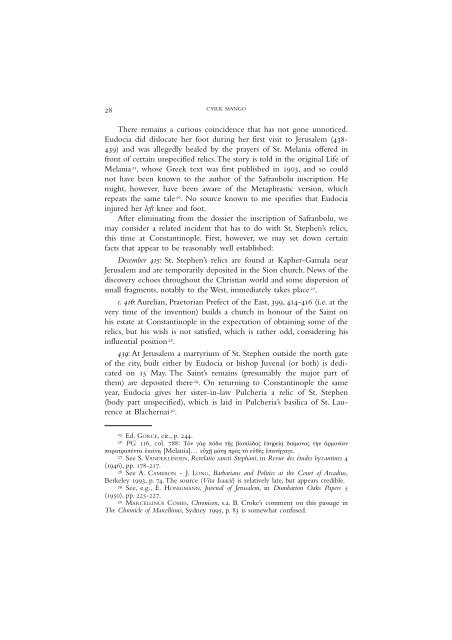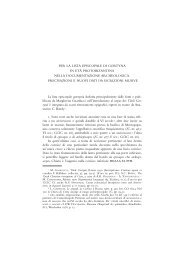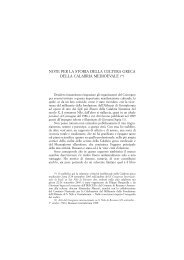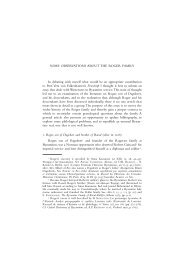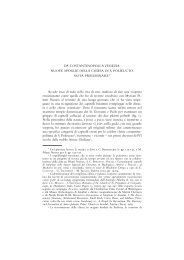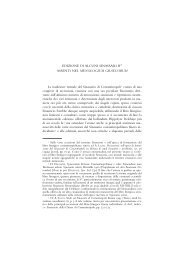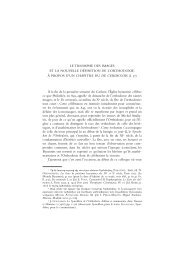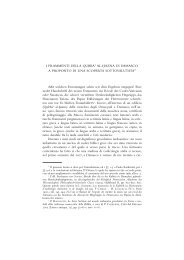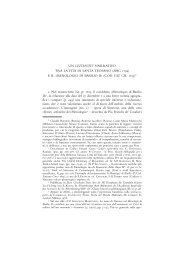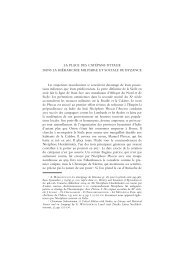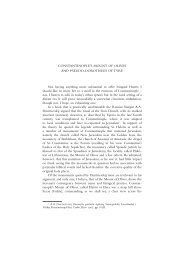Cyril Mango
Cyril Mango
Cyril Mango
Create successful ePaper yourself
Turn your PDF publications into a flip-book with our unique Google optimized e-Paper software.
28<br />
CYRIL MANGO<br />
There remains a curious coincidence that has not gone unnoticed.<br />
Eudocia did dislocate her foot during her first visit to Jerusalem (438-<br />
439) and was allegedly healed by the prayers of St. Melania offered in<br />
front of certain unspecified relics.The story is told in the original Life of<br />
Melania 25 , whose Greek text was first published in 1903, and so could<br />
not have been known to the author of the Safranbolu inscription. He<br />
might, however, have been aware of the Metaphrastic version, which<br />
repeats the same tale 26 . No source known to me specifies that Eudocia<br />
injured her left knee and foot.<br />
After eliminating from the dossier the inscription of Safranbolu, we<br />
may consider a related incident that has to do with St. Stephen’s relics,<br />
this time at Constantinople. First, however, we may set down certain<br />
facts that appear to be reasonably well established:<br />
December 415: St. Stephen’s relics are found at Kapher-Gamala near<br />
Jerusalem and are temporarily deposited in the Sion church. News of the<br />
discovery echoes throughout the Christian world and some dispersion of<br />
small fragments, notably to the West, immediately takes place 27 .<br />
c. 416: Aurelian, Praetorian Prefect of the East, 399, 414-416 (i.e. at the<br />
very time of the invention) builds a church in honour of the Saint on<br />
his estate at Constantinople in the expectation of obtaining some of the<br />
relics, but his wish is not satisfied, which is rather odd, considering his<br />
influential position 28 .<br />
439: At Jerusalem a martyrium of St. Stephen outside the north gate<br />
of the city, built either by Eudocia or bishop Juvenal (or both) is dedicated<br />
on 15 May. The Saint’s remains (presumably the major part of<br />
them) are deposited there 29 . On returning to Constantinople the same<br />
year, Eudocia gives her sister-in-law Pulcheria a relic of St. Stephen<br />
(body part unspecified), which is laid in Pulcheria’s basilica of St. Laurence<br />
at Blachernai 30 .<br />
25 Ed. GORCE, cit., p. 244.<br />
26 PG 116, col. 788: Τν γρ πδα τς ασιλίδς πηρεία δαίµνς τν ρµνίαν<br />
παρατραπέντα κείνη [Melania]… ε µνη πρς τ εθς πανήγαγε.<br />
27 See S. VANDERLINDEN, Revelatio sancti Stephani, in Revue des études byzantines 4<br />
(1946), pp. 178-217.<br />
28 See A. CAMERON - J. LONG, Barbarians and Politics at the Court of Arcadius,<br />
Berkeley 1993, p.74. The source (Vita Isaacii) is relatively late, but appears credible.<br />
29 See, e.g., E. HONIGMANN, Juvenal of Jerusalem, in Dumbarton Oaks Papers 5<br />
(1950), pp. 225-227.<br />
30 MARCELLINUS COMES, Chronicon, s.a. B. Croke’s comment on this passage in<br />
The Chronicle of Marcellinus, Sydney 1995, p.83 is somewhat confused.


